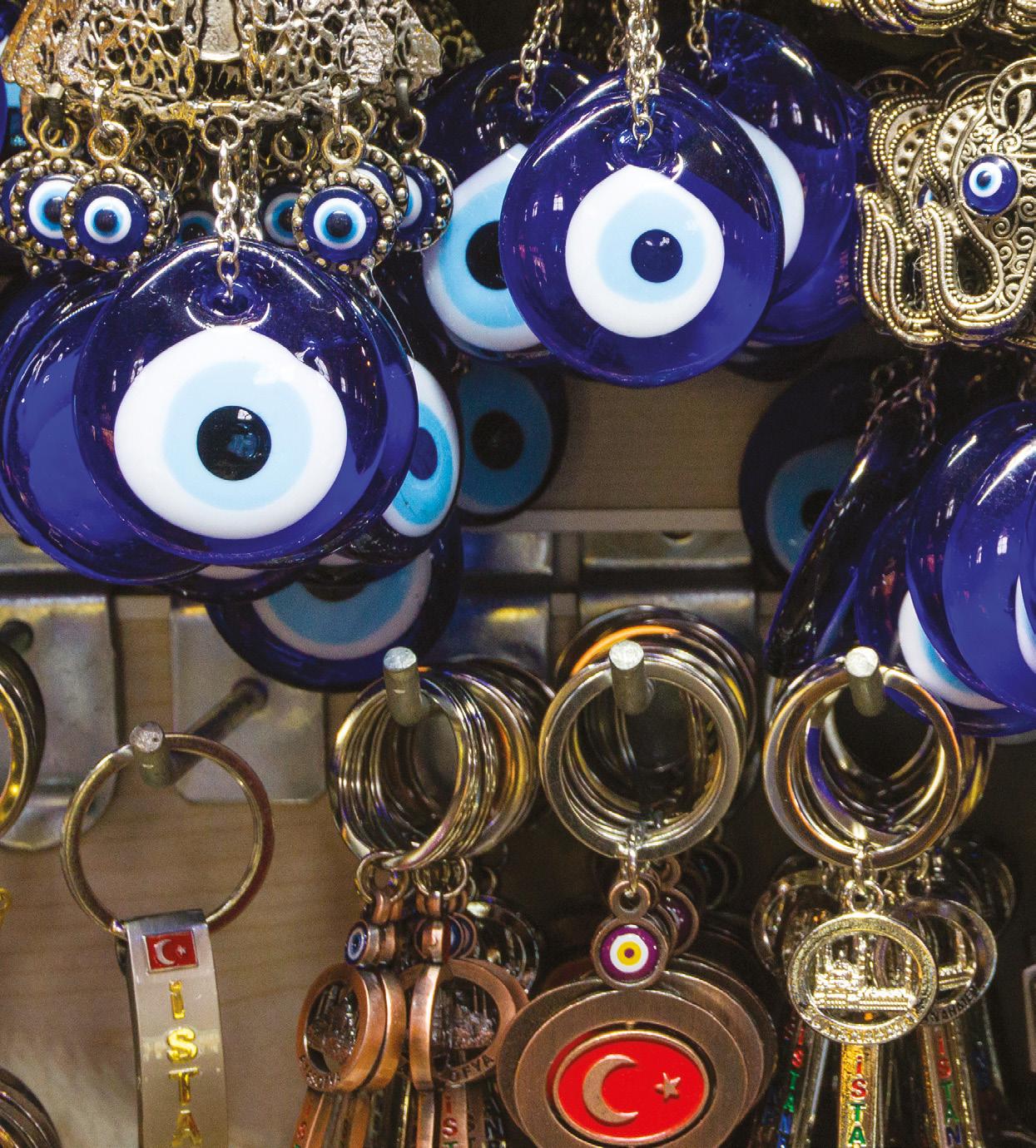
6 minute read
Flowers for success
from Holistic Therapist Magazine - Issue 38
by Holistic Therapist Magazine & The Holistic Health Magazine
AMULETS: Protective TALISMANS
Amulets have been used to provide the wearer with comfort and protection from harm and evil intent for centuries…
SINCE the earliest known civilisations, people have sought protection from physical harm and negative impacts and sought to bring abundance, good luck and wealth into their lives. Often these desires for protection or enhanced well-being and status have materialised in the form of amulets, which are found in ancient civilisations, folklore and modern religions alike. The need for wearable protection has shaped the creation and production of jewellery since the very first archaeological records of adornment objects.
In pre-literate civilisations, objects like feathers, animal and human bones, and attractive stones were held to offer protective qualities. By the time of the Ancient Egyptians, amulets not only included natural found objects, but also man-made representations of gods and supernatural beings produced in wood, clay or carved into gems. At this stage, amuletic forms expanded to include rings as well as pendants and other forms of adornment and were often used to offer protection to the dead as well as the living. This is why we often find amulets in association with grave goods. Amulets also indicated relative wealth and status in society, depending on the materials used and quality of craftsmanship as well as providing protection.
Just as a Christian might wear a St. Christopher medal when travelling, so the ancient civilisations used amulets to protect at particularly dangerous or momentous life stages. Pregnant women in Ancient Egypt would wear amulets depicting their goddess of childbirth, Taweret, while children were protected with an amulet of Bes, the lion-headed dwarf god. Going by the quantities of scarab, Eye of Horus, Pillar of Djel and other amulets that survive from this period, it may be that amulets afforded protection to all but the lowest rungs of society.
The Romans, too, used amulets for protection, particularly as magic and healing were less distinctly defined than current practice. They adopted the use of magical gemstones from the Greeks, with Mars often being carved on red jasper, Jupiter on chalcedony, Sol on the sunny yellow of heliotrope, and Bacchus on amethyst, which was said to protect the wearer from drunkenness. Jewish amulets of a similar period resemble tiny scroll cases, as divine images were forbidden. Sometimes, Roman amulets took the form of small boxes, often made of metal, which contained materials, such as sulphur powder, which were believed to repel evil. Small statues also held amuletic powers. Caligula’s father, Germanicus, died when his protective statue of Hecate was removed from under his pillow.
Given the high rate of child mortality, it is unsurprising that Roman children wore amulets from shortly after birth. The bulla was a lead pendant worn by free-born boys. Richer families had gold bullae. This was often worn with phallic symbols and carried at the neck in a cloth pouch. Girls wore the lunula until the eve of her marriage when it would be put aside with her toys and girlish clothing.
Towards the end of the Roman period, amulets changed form, with metal tubular forms becoming popular in Persia, Turkey, Syria and the Middle East. The tubes often contained thin, rolled up metal sheets that were scratched using a sharp tool to create protective spells and incantations often using the names of their gods.
During the Middle Ages, the use of talismans expanded from the wearable amulet into symbols, such as holy books, crosses or statues that were placed above or in the beds of those who were ill, and also to purely medicinal amulets. Some of the protective symbols used remain current today. The evil eye, the Hamsa or Hand of Miriam protect from evil intent, while religious protective symbols such as the cross, Star of David, Om symbol and even chakra mandalas all perform a similar dual role of declaring belonging or social status and being protected. The crucifix was considered to ward off demons and has long been portrayed as a vampire repellent in horror films. Other Christian iconography that might be considered talismanic includes Catholic Religious medals, portable icons from the orthodox faith and the Chi-Rho fish symbol used by early Christians. This has now evolved so that it is most commonly seen as a car bumper sticker, presumably providing protection from bad drivers and road rage.
Islam too has its tradition of amulets. A 2012 survey of Muslims showed that 20-26% of Muslims across Africa, Asia and South East Europe wore one or more amulets, while a third to two thirds believed that the Evil Eye exists and up to 40% had some form of object to protect against it. Since images are forbidden in most Muslim cultures, many amulets contain texts from prayers or scriptures
An amulet embodies spiritual seeking for guidance and safety. Historically, this has been sought from Gods or sanctified beings, but there are also secular amulets which are often go with attracting positive things such as wealth, love or luck into the life of the wearer, rather than protection from evil or negative experiences. Such amuletic devices are found in nearly all cultures. We are all familiar with the four-leaf clover, the lucky rabbit’s foot or the horse-shoe worn in the form of a charm on a bracelet. Indeed, the charm bracelet may be considered as a multiple amulet. Other forms may be less familiar to us, for example, in England, carrying an acorn was believed to protect from illness or speed up the healing process. Some Polish people carry a few scales from the carp eaten for Christmas dinner in their wallets to ensure good fortune, while many Italians wear a cornicello, a horn shaped pendant which counters the evil eye and keeps marriages happy

Protective Gems
Just as raw gemstone crystals are associated with different protective, balancing and attractive properties in crystal healing, so cut gems play an important role in Vedic Astrology. Gems have long been carved and incorporated into amuletic jewellery, such as the intaglio rings of the classical period. Some stones are said to offer healing properties, while others confer luck or material good fortune. This association between stone type and birth also exists in the western tradition, with birthstones allocated to each month or zodiac sign.
Precious stones associated with Vedic Astrology include, diamond, ruby, emerald and blue and yellow sapphires. Red coral, Hessonite garnets, Turquoise, Onyx, Agate, Laboradorite, Amber, Lapis Lazuli and several forms of quartz, as well as stones demonstrating cat’s eye diffraction are also used.
The principal beneficial stone is associated with the ascendant of birth, though there are normally two or three stones from which the astrologer makes a choice depending on other factors in the birth chart. n
ASCENDANT STONES ASCENDANT STONES
Aries
red coral, ruby, yellow sapphire
Libra
diamond, blue sapphire, emerald
Taurus
diamond, blue sapphire, emerald
Scorpio
red coral, yellow sapphire, natural pearl
Gemini
emerald, diamond, sapphire, blue sapphire
Sagittarius
yellow sapphire, red coral, ruby
Cancer
Leo
pearl, red coral, yellow sapphire
ruby, yellow sapphire, red coral.
Capricorn
Aquarius
blue sapphire, diamond, emerald
blue sapphire, emerald, diamond
Virgo
emerald, blue sapphire, diamond
Pisces
yellow sapphire, natural pearl, red coral










